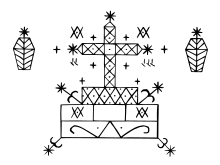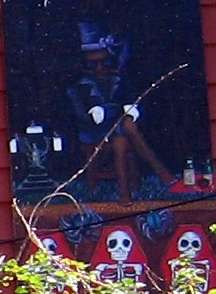Baron Samedi
| Baron Samedi | |
|---|---|
 Veve for Baron Samedi | |
| Loa of death and fertility | |
| Venerated in | Haitian Vodou, Louisiana Voodoo, Folk Catholicism |
| Feast | November 2 |
| Attributes | Rum, tobacco, cigar, top hat, glasses with missing lens |
| Patronage | Death, tombs, gravestones, cemeteries, dead relatives, obscenities, healing, smoking, drinking, disruption, spirits |


Baron Samedi (English: Baron Saturday) also written Baron Samdi, Bawon Samedi, or Bawon Sanmdi, is one of the loa of Haitian Vodou. Samedi is a loa of the dead, along with Baron's numerous other incarnations Baron Cimetière, Baron La Croix, and Baron Kriminel. He is syncretized with Saint Martin de Porres.
He is the head of the Guédé family of loa. His wife is the loa Maman Brigitte.
Portrayal
He is usually depicted with a top hat, black tail coat, dark glasses, and cotton plugs in the nostrils, as if to resemble a corpse dressed and prepared for burial in the Haitian style. He is frequently depicted as a skeleton (but sometimes as a Black man that merely has his face painted as a skull), and speaks in a nasal voice. The former President for Life of Haiti, François Duvalier, modeled his cult of personality on Baron Samedi; he was often seen speaking in a deep nasal tone and wearing dark glasses.[1]
He is noted for disruption, obscenity, debauchery, and having a particular fondness for tobacco and rum. Additionally, he is the loa of resurrection, and in the latter capacity he is often called upon for healing by those near or approaching death, as it is only the Baron that can accept an individual into the realm of the dead.[2][3]
Baron Samedi spends most of his time in the invisible realm of vodou spirits. He is notorious for his outrageous behavior, swearing continuously and making filthy jokes to the other spirits. He is married to another powerful spirit known as Maman Brigitte, but often chases after mortal women. He loves smoking and drinking and is rarely seen without a cigar in his mouth or a glass of rum in his bony fingers. Baron Samedi can usually be found at the crossroads between the worlds of the living and the dead. When someone dies, he digs their grave and greets their soul after they have been buried, leading them to the underworld.
Connection to other loas
Baron Samedi is the leader of the Guédé, loa with particular links to magic, ancestor worship and death.[4] These lesser spirits are dressed like the Baron and are as rude and crude but not nearly as charming as their master. They help carry the dead to the underworld.[5]
Activities
As well as being master of the dead, Baron Samedi is also a giver of life. He can cure any mortal of any disease or wound, if he thinks it is worthwhile. His powers are especially great when it comes to vodou curses and black magic. Even if somebody has been afflicted by a hex that brings them to the verge of death, they will not die if the Baron refuses to dig their grave. So long as this mighty spirit keeps them out of the ground, they are safe.
He also ensures that all corpses rot in the ground to stop any soul from being brought back as a brainless zombie. What he demands in return depends on his mood. Sometimes he is content with his followers wearing black, white or purple clothes or using sacred objects; he may simply ask for a small gift of cigars, rum, black coffee, grilled peanuts, or bread. But sometimes the Baron requires a vodou ceremony to help him cross over into this world.
References
Bibliography
- Voodoo: Search for the Spirit, “Abrams Discoveries” series. Laennec Hurbon. Harry N. Abrams, Inc. 1995. "Ghede"
- A Dictionary of World Mythology. Arthur Cotterell. Oxford University Press, 1997. "Vodou".
- The Voodoo Gods. Maya Deren. Granada Publishing Limited 1975.
- Conner, Randy P.; Sparks, David Hatfield; Sparks, Mariya (1998). Cassell's Encyclopedia of Queer Myth, Symbol and Spirit. UK: Cassell. ISBN 0-304-70423-7.